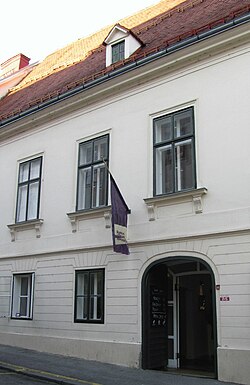코니페릴 알코올
Coniferyl alcohol | |
 | |
| 이름 | |
|---|---|
| 우선 IUPAC 이름 4-[(1E)-3-히드록시프로프-1-en-1-yl]-2-메톡시페놀 | |
| 기타 이름 4-히드록시-3-메톡시신나밀알코올 코니페롤 | |
| 식별자 | |
3D 모델(JSmol) | |
| 2048963 | |
| 체비 | |
| 첸블 | |
| 켐스파이더 | |
| ECHA 정보 카드 | 100.260.977 |
| EC 번호 |
|
| 케그 | |
PubChem CID | |
| 유니 | |
CompTox 대시보드 (EPA ) | |
| |
| |
| 특성. | |
| C10H12O3 | |
| 몰 질량 | 180.150 g/140−1 |
| 녹는점 | 74 °C (165 °F, 347 K) |
| 비등점 | 163~165°C(325~329°F, 436~438K) |
| 위험 요소 | |
| GHS 라벨링: | |
 | |
| 경고 | |
| H315, H319, H335 | |
| P261, , , , , , , , , , , | |
달리 명시되지 않은 한 표준 상태(25°C[77°F], 100kPa)의 재료에 대한 데이터가 제공됩니다. | |
코니페릴알코올은 화학식이3 HO(CHO63)CHCH2=CHCHOH인 유기화합물입니다. 무색 또는 백색 고체인 코니페릴알코올은 페닐프로파노이드 생화학 경로를 통해 생성되는 모노리놀 중 하나입니다.관련된 방향족 화합물과 공중합되면 코피페릴 알코올이 리그닌 또는 리그난을 [1][2][3]형성합니다.코피페린은 코피페릴 알코올의 글루코시드이다.코니페릴 알코올은 오제놀과 스틸베노이드 및 쿠마린의 생합성 중간체입니다.껌 벤조인은 상당한 양의 침엽수 알코올과 그 에스테르를 함유하고 있습니다.그것은 나체배엽과 혈관배엽 식물에서 발견됩니다.다른 두 가지 리그닌 단량체인 시나필 알코올과 파라코마릴 알코올은 앤지오스팜 식물과 풀에서 발견됩니다.
발생.
코피페릴알데히드로부터 탈수소효소 [3]작용으로 코피페릴알코올을 제조한다.
그것은 하악샘에서 [4]발견되는 꿀벌 페로몬의 일종인 여왕 레티누 페로몬이다.
개나리 중간 매체에서 디리젠트 단백질이 코피페릴 [5]알코올로부터 (+)-피노레시놀의 입체 선택적 생합성을 지시하는 것으로 확인되었다.최근 아라비도시스 탈리아나에서 두 번째 항안티보충성 디리젠트 단백질이 확인되었으며, 이는 [6]피노레시놀의 항안티 선택적 합성을 지시한다.
레퍼런스
- ^ Iiyama, Kenji; Lam, Thi Bach-Tuyet; Stone, Bruce A. (1994). "Covalent Cross-Links in the Cell Wall". Plant Physiology. 104 (2): 315–320. doi:10.1104/pp.104.2.315. PMC 159201. PMID 12232082.
- ^ 워트 보어잔, 존 랄프, 마리 바우처 "리그닌 생합성" 안누.플랜트 비올 목사님2003, vol. 54, 519–46. doi:10.1146/anurev.arplant.54.031902.134938
- ^ a b Li, Laigeng; Cheng, Xiao Fei; Leshkevich, Jacqueline; Umezawa, Toshiaki; Harding, Scott A.; Chiang, Vincent L. (2001). "The Last Step of Syringyl Monolignol Biosynthesis in Angiosperms is Regulated by a Novel Gene Encoding Sinapyl Alcohol Dehydrogenase". The Plant Cell. 13 (7): 1567–1586. doi:10.1105/tpc.010111. PMC 139549. PMID 11449052.
- ^ Keeling, C. I.; Slessor, K. N.; Higo, H. A.; Winston, M. L. (2003). "Isolation and identification of new components of the honey bee (Apis mellifera L.) queen retinue pheromone". Proc. Natl. Acad. Sci. U.S.A. 100 (8): 4486–4491. doi:10.1073/pnas.0836984100. PMC 153582. PMID 12676987.
- ^ Davin, L. B.; Wang, H. B.; Crowell, A. L.; et al. (1997). "Stereoselective bimolecular phenoxy radical coupling by an auxiliary (dirigent) protein without an active center". Science. 275 (5298): 362–366. doi:10.1126/science.275.5298.362. PMID 8994027. S2CID 41957412.
- ^ Pickel, B.; Constantin, M.-A.; Pfannsteil, J.; Conrad, J.; Beifuss, U.; Schaffer, A. (March 2007). "An Enantiocomplementary Dirigent Protein for the Enantioselective Laccase-Catalyzed Oxidative Coupling of Phenols". Angewandte Chemie. 53 (4): 273–284. doi:10.1007/s10086-007-0892-x. S2CID 195313754.



